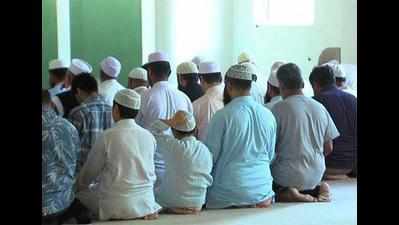- News
- City News
- guwahati News
- 'Bangladeshi' tag haunts Muslims in Darrang chars
Trending
This story is from December 4, 2016
'Bangladeshi' tag haunts Muslims in Darrang chars
Nine-year-old Malekuddin, a resident of Dhalpur char (sand bar), has been spending sleepless nights after receiving an eviction notice from a local court in Darrang district.

Picture only for representation.
GUWAHATI: Nine-year-old Malekuddin, a resident of Dhalpur char (sand bar), has been spending sleepless nights after receiving an eviction notice from a local court in Darrang district. A Class IV-student at a madrassa in nearby Dalgaon, Malekuddin has no idea about what led to the sudden crackdown.
Malekuddin is not alone. Members of the minority community living along the fertile Sipajhar riverine area of Darrang district are a worried lot.Increasing tension between them and the local Assamese over the past couple of months has culminated in a malicious poster campaign. Several posters, of unknown origin, have been circulated in the area in which members of the minority community have been labelled 'Bangladeshi migrants'.
While his elderly neighbours attribute the growing unease to the installation of BJP in Dispur, Malekuddin, who has no idea about the persecution faced by his forefathers in Darrang during the height of the Assam Agitation, could only hope for a miracle.
"I don't know anything about politics. My request to the government is to allow us to live peacefully in our homes. My family makes a living by cultivating corn but we didn't dare to farm this year because of this eviction notice," said the weary youngster who, along with some of his neighbours, was in Guwahati on Saturday.
As BJP leaders of Sipajhar have been urging chief minister Sarbananda Sonowal to make the eponymous revenue circle free of doubtful citizens, 60000-odd families in Dhalpur who had settled in the sand bars of the area since 1978 are facing the heat. They fear that Dhalpur - a major producer of vegetables - might soon turn into a conflict zone if the government did not take steps to protect them.
Jaynal Abedin, an elderly neighbour of Malekuddin, said settlement in Dhalpur char began in 1978 when flood-affected people from Kamrup, Barpeta and parts of Darrang began migrating there for shelter. "This land was not settled by Bangladeshis. We all are genuine Assamese," the 65-year-old said.
A delegation of students and scholars comprising representative of the Post Graduate Students' Union (PGSU) of Gauhati University visited the greater Dhalpur area recently to assess the situation.
"In Dhalpur, as many as 37 primary schools, four high schools, one higher secondary school and 39 Anganwadi kendras have been set up by the government. There are several health centres here which are controlled by the government. We are shocked at the political conspiracy against the people of Dhalpur who have already been victims of floods and erosion,"said Sanjib Talukdar, president of PGSU.
Malekuddin is not alone. Members of the minority community living along the fertile Sipajhar riverine area of Darrang district are a worried lot.Increasing tension between them and the local Assamese over the past couple of months has culminated in a malicious poster campaign. Several posters, of unknown origin, have been circulated in the area in which members of the minority community have been labelled 'Bangladeshi migrants'.
While his elderly neighbours attribute the growing unease to the installation of BJP in Dispur, Malekuddin, who has no idea about the persecution faced by his forefathers in Darrang during the height of the Assam Agitation, could only hope for a miracle.
"I don't know anything about politics. My request to the government is to allow us to live peacefully in our homes. My family makes a living by cultivating corn but we didn't dare to farm this year because of this eviction notice," said the weary youngster who, along with some of his neighbours, was in Guwahati on Saturday.
Interestingly, the eviction notice was addressed to the nine-year-old boy, not his father or any other older family member.
As BJP leaders of Sipajhar have been urging chief minister Sarbananda Sonowal to make the eponymous revenue circle free of doubtful citizens, 60000-odd families in Dhalpur who had settled in the sand bars of the area since 1978 are facing the heat. They fear that Dhalpur - a major producer of vegetables - might soon turn into a conflict zone if the government did not take steps to protect them.
Jaynal Abedin, an elderly neighbour of Malekuddin, said settlement in Dhalpur char began in 1978 when flood-affected people from Kamrup, Barpeta and parts of Darrang began migrating there for shelter. "This land was not settled by Bangladeshis. We all are genuine Assamese," the 65-year-old said.
A delegation of students and scholars comprising representative of the Post Graduate Students' Union (PGSU) of Gauhati University visited the greater Dhalpur area recently to assess the situation.
"In Dhalpur, as many as 37 primary schools, four high schools, one higher secondary school and 39 Anganwadi kendras have been set up by the government. There are several health centres here which are controlled by the government. We are shocked at the political conspiracy against the people of Dhalpur who have already been victims of floods and erosion,"said Sanjib Talukdar, president of PGSU.
End of Article
FOLLOW US ON SOCIAL MEDIA










